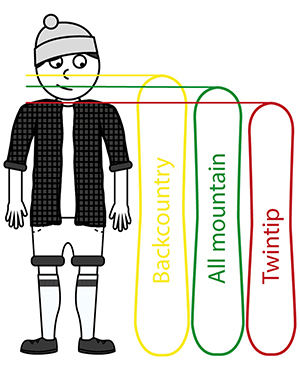Buying Snowboards
The choice of snowboard will depend largely on your level and whether you are passionate about riding on the piste, in the park or in the off-piste. Other important factors to be considered are your foot size, weight and height.
What length and width of snowboard should you choose?
- Snowboard Length is determined by your preference for terrain and your height. As a rule, your snowboard should go somewhere between the shoulder and the center of your head. In general, longer boards than that are recommended for backcountry/off-piste, whereas shorter boards are suitable for freestyle performances. A board in between is versatile and suitable for all mountain riding.
For beginners and kids, it is normally recommended choosing a bit shorter board to achieve an easy and fun experience on your snowboard. You will find these size guide on the individual snowboard product pages if available.
Recently, the brands offer model-specific size charts based on weight, too. This is probably the best option for choosing the right snowboard length. - Snowboard Width is mainly distinguished between Standard and Wide. Wide boards are recommended for shoe size 44 and over. As an exception, this does not count for the junior wide boards.

There are three types of snowboards
- Twintip snowboards are suitable for park and tricks, but is also fun to play with on the piste. The front and back of the snowboard are 100% identical shaped and the bindings are centrally placed, making it easy to ride both ways and land tricks with.
- All mountain snowboards are the most versatile boards. The design is similar to a twintip snowboard in shape, but the bindings, flex and balance point are moved backwards on the snowboard. This type of snowboard is a great purchase for most people, as it is suitable all mountain, meaning both on the piste, in the park and in off-piste.
- Backcountry: This type of snowboard is made for deep powder in the off-piste. The shape of a backcountry snowboard is very similar to a surfboard, and the large surface of the board gives a great flow in deep snow.
Snowboard designs
Shape
- Directional: Is designed to ride only in one direction and is often used on the piste or off-piste. This shape comes with a stiffer design at the end of the board, which provides stability at high speed.
- Twin: Designed with an identical front and back, which makes it suitable for park and tricks. Twin-shaped snowboards can run in both directions.
- Directional twin: Is a mix of both shapes, often designed for all mountain and freestyle snowboards.
Baseline design
A baseline (a snowboards bottom) varies and can be either camber, rocker or flat designed. These designs are often combined, depending on the purpose of the snowboard.

- Rocker: Valid when a snowboard is curving upwards in the top and/or the end of the snowboard, making it ideal for powder snow and easy turns. Rocker prevents resistance and makes it a solid board in the park.
- Camber: The nose and tail of a snowboard is pressed down into the snow, which increases the contact area with the snow and gives a better edge grip.
- Flat: Provides 100% contact with the snow surface, resulting in more stability than a traditional rocker and offers easy turns.
